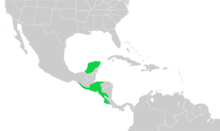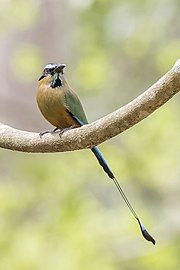Turquoise-browed motmot
| Turquoise-browed motmot | |
|---|---|

| |
| E. s. apiaster, Honduras | |
| Scientific classification | |
| Domain: | Eukaryota |
| Kingdom: | Animalia |
| Phylum: | Chordata |
| Class: | Aves |
| Order: | Coraciiformes |
| Family: | Momotidae |
| Genus: | Eumomota P.L. Sclater, 1858 |
| Species: | E. superciliosa
|
| Binomial name | |
| Eumomota superciliosa (Sandbach, 1837)
| |

| |
The turquoise-browed motmot (Eumomota superciliosa) is a colourful, medium-sized

The bird is 34 cm (13 in) long and weighs 65 g (2.3 oz). It has a mostly grey-blue body with a rufous back and belly. There is a bright blue strip above the eye and a blue-bordered black patch on the throat. The
Unlike most bird species, where only males express elaborate traits, the turquoise-browed motmot expresses the extraordinary racketed tail in both sexes. Research indicates that the tail has evolved to function differently for the sexes. Males apparently use their tail as a sexual signal, as males with longer tails have greater pairing success and reproductive success.
The
The turquoise-browed motmot is a well-known bird in its range. It has acquired a number of local names including guardabarranco ("ravine-guard") in Nicaragua, torogoz in El Salvador (based on its call) and pájaro reloj ("clock bird") in the Yucatán, based on its habit of wagging its tail like a pendulum. In Costa Rica it is known as momoto cejiceleste or the far-less flattering pájaro bobo ("foolish bird"), owing to its tendency to allow humans to come very near it without flying away.
References
- . Retrieved 12 November 2021.
- Imprenta Nacional de El Salvador: 6. 19 November 1999. Retrieved 22 July 2017.
- ^ "Ley No. 795 que declara al guardabarranco, ave nacional de Nicaragua". Diario Oficial (in Spanish) (118). Managua: La Gaceta. 25 June 2012. Retrieved 22 July 2017.
- .
- S2CID 8966707.
- .
- S2CID 6828682.
- Fogden, Susan C. L.; Fogden, Michael; Fogden, Patricia (2005). A Photographic Guide to Birds of Costa Rica. New Holland. ISBN 978-1-84330-960-4.
- Howell, Steve N. G.; Webb, Sophie (1995). A Guide to the Birds of Mexico and Northern Central America. Oxford University Press. ISBN 978-0-19-854012-0.
- Ridgely, Robert S.; Gwynne Jr., John A. (1989). A Guide to the Birds of Panama with Costa Rica, Nicaragua and Honduras. Princeton University Press. ISBN 978-0-691-02512-4.
External links
- Turquoise-browed Motmot research by Troy G. Murphy at Trinity University, Texas
- Stamps[usurped] (for El Salvador, Honduras, Mexico, Nicaragua, and Panama) at bird-stamps.org[usurped]
- Turquoise-browed motmot photo gallery at VIREO (Drexel University)
- "Turquoise-browed motmot media". Internet Bird Collection.
- Turquoise-browed motmot in Laguna de Apoyo Nature Reserve, Nicaragua
- Turquoise-browed motmot species account at Neotropical Birds (Cornell Lab of Ornithology)
- Interactive range map of Eumomota superciliosa at IUCN Red List maps





